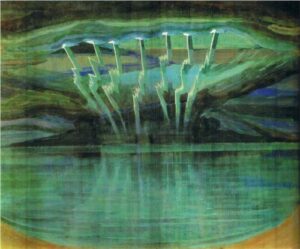
Ciurlionis – Lightning (source)
Direct damage spells are much maligned, especially among those who are interested in elements of the game such as exploration and problem solving in addition to combat. Even within the category of attack sorcery, magic missile in particular is a rather lackluster spell in a number of different ways, especially for a low level traditional magic-user. It doesn’t seem effective enough (despite automatically hitting in most interpretations), because it only does something like 1d6+1 damage. The primary benefit provided is to have some way of damaging monsters with immunities to mundane weapons, but even then the damage is not likely to be enough to make a difference.
However, playing as a sorcerer, it is also true that it is quite pleasing to call conflagration down upon the heads of your enemies. There is the danger, though, that available attack magic will displace other interesting spells. Some approaches to this problems have been unlimited use attack cantrips or at-will magic (such as the ray of frost or cloud of daggers) in games like Pathfinder and 4E. This approach preserves the viability of more unique spells, but also makes magic too common for my tastes, and does not distinguish it enough from the methods employed by other classes. Instead, why not make the attack magic more powerful, but allow sorcerers to cast it in place of any prepared spell? This maintains both distinctiveness and resource constraints.
If you don’t go in for the idea of sorcerers being able to trade in prepared spells for default effects (because it goes against the preparation ethos of the class), you could also probably just make this a standard first level spell. Another variation, if you wanted the damage to scale with level, would be to use 2d6 + level rather than just 2d6 (intelligence bonus could also be incorporated here, if desired). Or, if using traditional ranked spells, make the bonus damage dependent upon the level of spell sacrificed rather than the sorcerer’s experience level.
Maleficence
Any prepared spell may be expended to conjure calamity, doing 2d6 damage (save for half) to all in a melee area or to a single enemy. Each sorcerer’s maleficence is unique and should be determined at the time of character creation by choice of a single additional descriptor (fire, lightning, shadow, cold, acid, and so forth), which can also cause secondary effects (igniting flammable objects, freezing a small pool, doing extra situational damage based on enemy weaknesses). When both damage dice come up 6, or if a natural 1 is rolled for the saving throw, the magic permanently disfigures the place or person afflicted (some examples include permafrost, an affinity for ghosts, a strange high pitched whining, the attention of a demon, a scar that senses the presence of the sorcerer).








